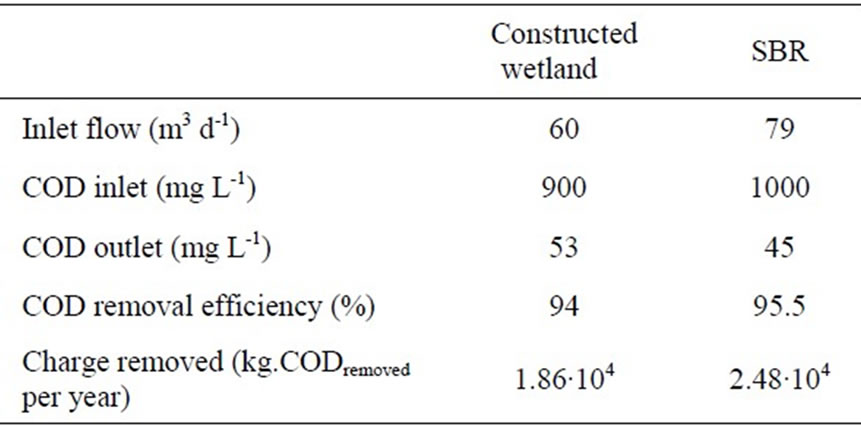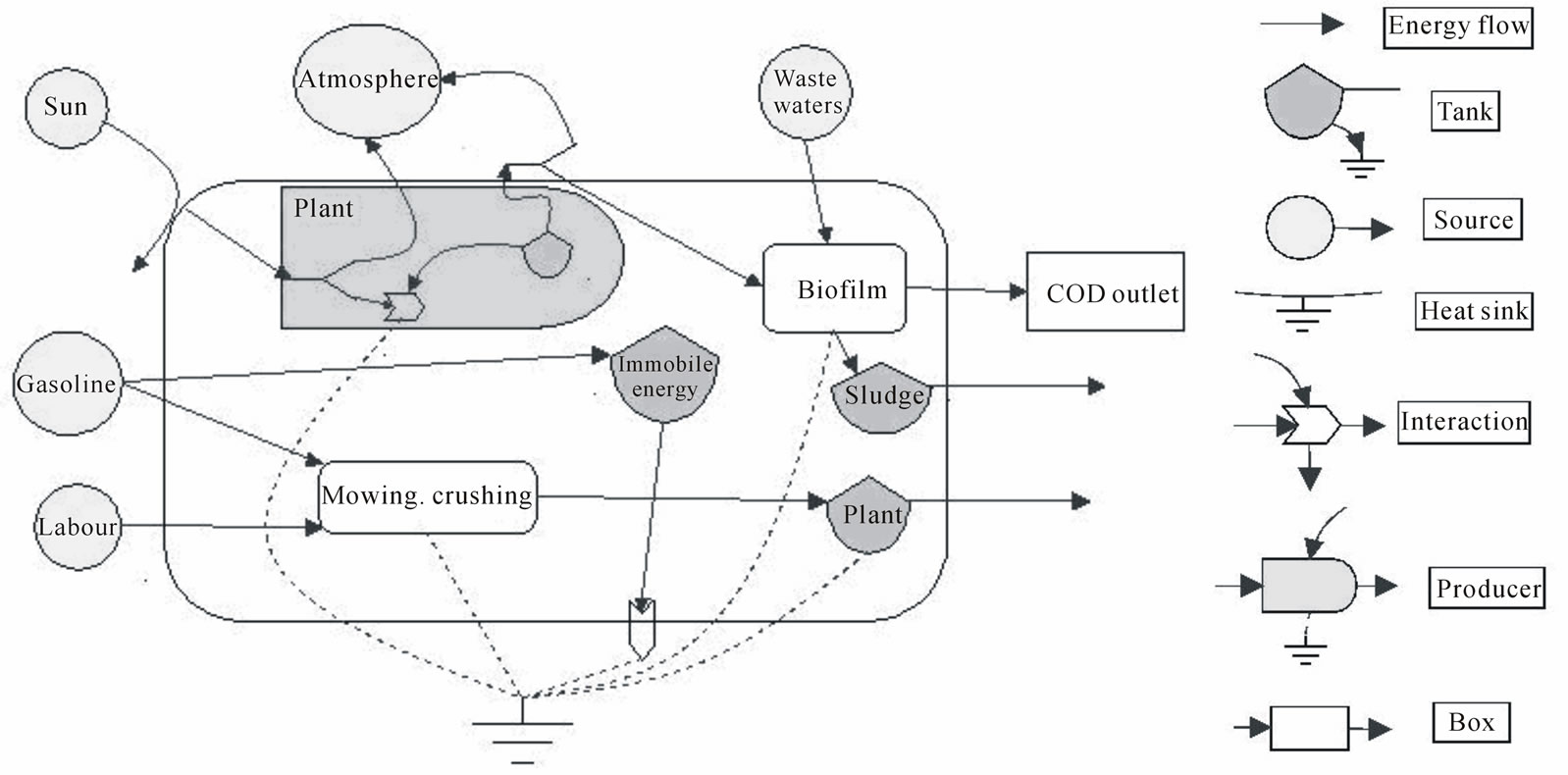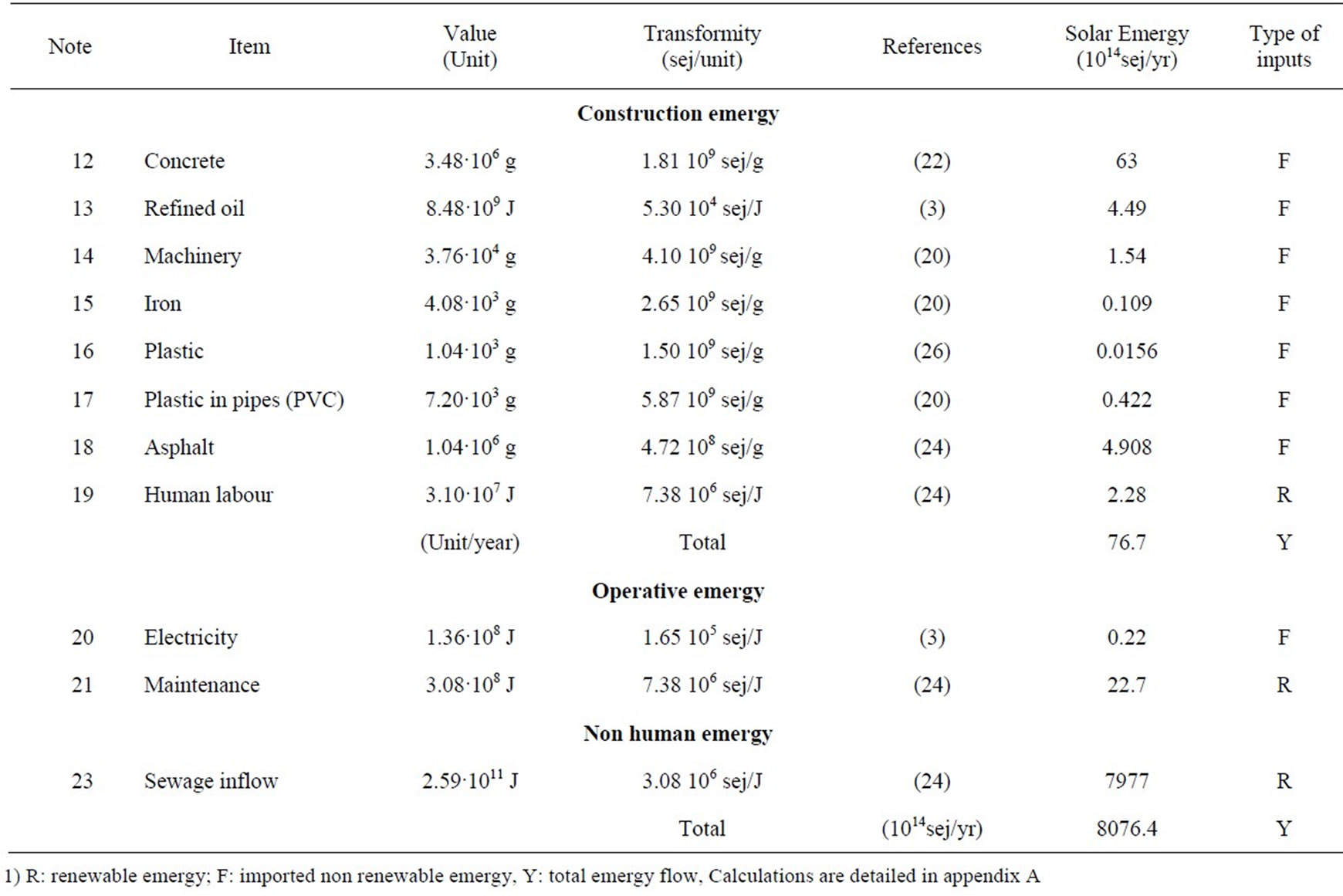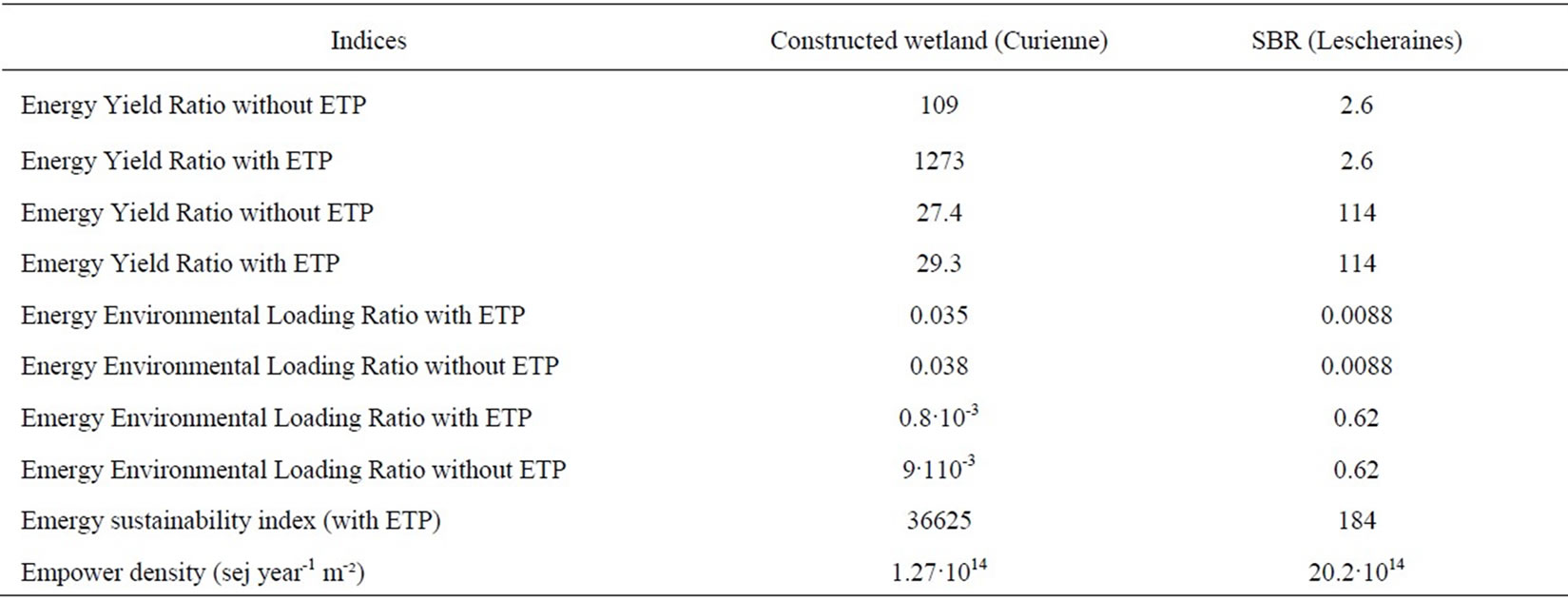Energy and Emergy Analysis to Evaluate Sustainability of Small Wastewater Treatment Plants: Application to a Constructed Wetland and a Sequencing Batch Reactor ()
1. Introduction
Sustainability is the potential for long-term maintenance of human activities that have environmental, economic and social dimensions. In rural areas, all over the world, there is a need for sustainable wastewater treatment systems that require low-maintenance, low electric power and present high pollutants removal efficiency. For example, constructed wetlands can be a good answer to this request because they are not technology sophisticated and do not require intensive maintenance and energy to have high pollutant removal efficiency [1]. One approach to assess the sustainability is based on energy and requires a rigorous quantitative approach in terms of energy balance to estimate the energetic dependence of the system. Energy analysis is the process of determining the energy required directly and indirectly to allow a system to produce a specified good or service [2]. The notion of a system is not restricted to physical machines such as car engines but can be extended to economical systems or ecosystems. In this study, the Gross Energy Requirement (G.E.R.) method was used to globally compare a constructed wetlands wastewater treatment plant with a conventional activated sludge system i.e., a sequencing batch reactor. As this analysis is focused on process inputs which require the use of fossil fuel equivalent to operate, an emergy analysis [3] was also carried out to complete the classical energy analysis. Energy quality can be related to distribution, flexibility, ease of transportation, convertibility, etc. This concept of quality requires a new analysis of energy that recognized that not all forms of energy have the same quality. This emergy method takes into account the energy memory [3] since it measures the energy as direct or indirect fluxes previously required for a product or service. Besides, emergy analysis uses the thermodynamic basis of all forms of energy and materials and converts them into sunlight equivalents, [4,5] which facilitates a wider range of comparisons. The common unit used is solar emergy joule, abbreviated sej.
The energetic and emergetic methods are complimentary [6]. The energy inputs taken into account can be both current and historical, as well as being possibly direct or indirect. The emergy analysis has already been used for analysis of wastewater treatment processes, for an evaluation of a conventional activated sludge treatment system [7], for emergy required for the complete treatment of municipal wastewater [8], for the sustainability assessment of a constructed wetland [9] and for the comparison of constructed wetland and conventional wastewater treatments [10]. A recent study has been conducted to evaluate the performance and the sustainability of a model constructed wetland treatment system in comparison with conventional systems i.e. waste stabilization ponds and a sequencing batch reactor using emergy analysis [11]. This present study sheds a new light on the comparison of wastewater treatment plants, by using a parallel energetic and emergetic analysis and defines a new unit, the “Functional Efficiency Index” abbreviated FEI to describe the energetic efficiency of the facilities, expressed in kJ per year and per kg of removed COD. To protect the environment, especially water resources, large and small cities are equipped with wastewater treatment plants based on activated sludge or bacterial beds processes. These processes assumed to be intensive, are not economically adapted for dispersed population in rural areas, mainly due to the construction cost of sewage collectors. In rural areas constructed wetlands could be used as an alternative technology to treat wastewater. In fact, they present the characteristics of low maintenance cost and high efficiency [12] and are widely studied for wastewater management and water pollution controls today [13,14]. Interest has been steadily increased in the world over the last three decades in the use of natural aquatic processes for the treatment of polluted waters. This interest has been driven by: 1) the growing recognition of the natural treatment functions performed by wetlands and organisms living in these ecosystems, 2) the escalating costs of conventional treatment methods, and 3) a growing appreciation for the potential ancillary benefits provided by such systems. The objective of this study was to evaluate the sustainability of two small treatment plants situated in the French Alps. The first system is a Sequencing Batch Reactor (SBR) which is a concrete and electricity dependent intensive process. The second is a constructed wetland, usually considered as an extensive process. The two studied facilities have similar treatment capacity (600 inhabitants) and similar removal efficiencies.
The purpose of applying energy and emergy analysis to these two processes is to prove the capacity to answer to sustainable development criteria in particular, to determine to what extent they are dependent to human interventions for building and maintenance.
2. Experimental Design & Measurements
2.1. Description of the Wastewater Treatment Plants
The two plants are located in a rural mountainous area and treat domestic sewage for the same number of about 600 PE and with almost identical removal efficiency (a) The constructed wetland is situated in Curienne (France) (45°34’2” North, 6°0’30” East) at an elevation of 720 m and consists in a three-stage system with one vertical flow and two horizontal sub-surface flow as shown in Figure 1. Each bed is constituted by two layers, the lower layer with washed pea-gravels (6-20 mm) for about 0.5 to 0.7 m height and the upper layer with fine gravels (1-4 mm) for about 0.2 to 0.3 m height. Three kinds of plants have been used in this station, cattails (Typha latifolia), bulrush (Scirpus lacustris) and common reed (Phragmites australis). Water level was set about 5 cm below the bed surface with a standpipe. The bottom slope was in the range of 0.5 to 1.5% and all slide slopes of the wetland cells were constructed on a 2:1 ratio. The basins were sealed off by compacted clay. The Hydraulic Residence Time is close to 4.5 days and the surface load is 3.2 m2 PE-1. A detailed description of this particular station has already published previously [15]. Alternative loading cycles are realized at the first stage with a recovery period of about 15 days for each basin. Mean hydraulic loading rate was 5 cm/d.
The Sequencing Batch Reactors Activated Sludge (Figure 2) is situated in Lescheraines (France) (45°42’25” North, 6°6’21” East) at an elevation of 600 m and is at a flying distance of 20 km from Curienne. The plant has

Table 1. Characteristics and performance of the two treatment plants.

Figure 1. Schematic diagram of the constructed wetlands system in curienne.
two 150 m3 reactors with 4 cycles a day. Each cycle of 6 hours is divided into typical sequences (fill + reaction, settle sludge + water evacuation and idle). Effective Hydraulic Retention Time and effective Sludge Retention Time are respectively 2.4 and 33 days. Aerobic fraction represents 55% of the total cycle time and the fraction devoted to fill + reaction sequence is equal to 66%. The SBR works at weak loads: 0.28 kg of COD kg SS-1day-1 and 0.15 kg COD m-3 day-1.
The climate for the two wastewater treatment plants is characterized by an average rainfall of about 1500 mm/ year and an average air temperature of about 10°C sswith extremes range between –15 and +35°C according to the meteorological data collected in a nearby area of the treatment plants.
The 24 h volume-proportional composite effluent samples were analyzed for total suspended solids (TSS), five-day biological oxygen demand (BOD5), and chemical oxygen demand (COD). Analyses were performed according to standardized methods [16].
2.2. Energy Analysis
The energy consumed and energy of the product from the flow entering and coming out of the treatment plants was measured. The Gross Energy Requirement method described by Franzese [6] was strictly followed in a first approach and thus only renewable and non renewable energies were quantified. Wastewater entering the system provides a large quantity of energy because it contains organic polymer (sugar, oil, proteins) rich in chemical energy. This energy will support the development of microorganisms and ultimately, the activated sludge or the constructed wetlands system. As organisms in-

Figure 2. Schematic diagram of the SBR system in lescheraines.
volved in the treatment gain their energy from oxidation/reduction reactions, with transfer of electrons from donors to terminal electron acceptors, chemical oxygen demand was used to determinate mass balances of reactions taking place in the treatment plants [16,17]. All energies were expressed in kilojoules (kJ). A functional efficiency index (FEI) was defined and expressed in kJ per year and per kg of removed COD. This index measures the energetic efficiency of the facility. Energy to conduct and to maintain the facilities (operational expense) and energy to build the plant (investment expenses) are taking into account for the evaluation of this index. The lifetime of the facilities are estimated to be 50 years for the SBR and for the constructed wetlands. A lifetime of 20 years is usually used for conventional constructed wetlands but based on cumulative experience with existing constructed wetlands in France; a life time of 50 years appears to be a more realistic estimation.
The dimension of this index is a power expressed per kg of removed COD and corresponds to useful power used to remove one kg of COD. A similar index, the ecological waste removal efficiency (EWRE) was proposed by JB Zhou [10]. The EWRE index takes into account emergy, not energy, and uses sej per kg of removed COD as unit. The two indexes become similar if measuring for a defined time period, and with some assumptions to integrate the energy used to build the facility.
Consumption of energies were measured on the premises either starting from statements of consummation from the builder (fuel, electricity) or by converting the material masses and the work hours using conversion factors. The energy used for operational expenses (dioxygen bubbling and mechanical stirring) was determined by the facility electrical consumption.
For energy balance, two hypotheses were made:
-The wastewater treatment plants function under aerobic condition. O2 concentration was higher than 3-4 mg L-1 for the two systems. For these concentration values, a total diffusion into the biofilm was observed [18,19].
-The period of sampling is one year. All data were collected during years 2003 and 2004.
2.3. Emergy Analysis
The general methodology for emergy evaluations has been explained in different publications [3,20]. Emergy analysis is commonly performed through a sequence that includes drawing energy flow diagrams and the construction of emergy tables [21]. Systems diagrams are used to show the inputs that are evaluated and summed to obtain the energy or emergy of a resulting flow or storage. The purpose of the system diagram is to conduct an inventory of processes, storages and flows that are important to the considered system. Tables of the flows of materials, labour, and energy are constructed from the diagram. Raw data on flows and storage reserves are converted into energy and emergy units and then summed for a total energy or emergy flow to the system. The Figure 3 shows the energy diagram of the constructed wetlands system.

Figure 3. System diagram of constructed wetlands: curienne.
The plants are represented by a producer symbol which controls all the flows around it, allowing the biofilm to exist and to treat the wastewater entering the system. A parallel path represents the maintenance indispensable to the functioning of the treatment plant.
Figure 4 stands for the energy diagram of the SBR. Three different paths are shown there according to the flows of non renewable and renewable energy and the treatment of the water. The emergy analysis tables were built based on these energy diagrams. The annual amount of input and output of each flow was quantified in joules or grams. These amounts were multiplied by the respective amounts of direct and indirect solar energy to obtain emergy intensities called transformities if product (output) is expressed in energy (sej/J) and specific emergies if product is expressed in mass (sej/g). The transformities and specific emergies were all used from published data [5,22-25].
3. Results and Discussion
3.1. Energy Analysis
In the two energetic diagrams (Figures 3 and 4), immobilized energy (Ei) that is the natural energy used in the construction of the process, is represented by a tank. The energy brought back to the FEI is the leak-flow of this tank. The tank loses EiFEI kJ per year and per kg of eliminated COD: EiFEI = Ei/(d. mCOD); With d: life duration of the plant (year) and mCOD: COD loading (kg/year). Others methods than a straight-line method could have been used to estimate the depreciation of the system using for example a logarithmic equation which would have represented the energy flows necessary to maintain the system. In that case, the shape of the curve would have been linked to the fact that, older a system is, faster its efficiency decrease. In this study, the choice of considering the COD eliminated is directly related to the objective of the studied process.
Looking at the energy consumed for building the facilities and taking into account a life cycle of 50 years for the SBR and for the constructed wetland, it can be observed that the constructed wetland consumed less energy than the SBR, 127 kJ y-1 kg-1 CODremoved versus 984 kJ y-1 kg-1 CODremoved (Table 2).
The chemical energy embedded in the organic matter of the wastewater represents an important part of the inputs (63-64%) and is similar between the two systems evaluated.
Applying the principles of the G.E.R. method, constructed wetlands use less energy than the SBR, 10 730 kJ year-1 kg-1 CODremoved versus 16 876 kJ year-1 kg-1 CODremoved. However, this calculation does not take into account two important phenomena occurring in the constructed wetland: photosynthesis and evapotranspiration.
Photosynthesis is essential for the functioning of the constructed wetland and the solar energy store as biomass is significant. The overall equation is:
nCO2 + nH20 → nO2 + CnH2n0n
with ΔG0 = 477.8 kJ·mol-1 for n = 1 (standard conditions).
The solar energy used by photosynthesis was evaluated by the dry biomass produced annually by the constructed wetlands system. By taking into account this

Table 2. Mean energy consumption for the two wastewater treatment plants during one year (years 2003 and 2004).

Figure 4. System diagram of sequencing batch reactor: Lescheraines.
phenomenon, the quantity of energy consumed by the constructed wetland and the SBR was almost identical, 1.40·104 for the constructed wetlands versus 1.69·104 for the SBR. That would mean that photosynthesis energy in constructed wetland corresponds to maintenance and electricity energy in SBR (Table 2).
Evapotranspiration must be taken into account because it plays a very important role in the plant physiology and pollutants removal [25]. Evapotranspiration was evaluated by measuring the difference between inlet flow and outlet flow of the constructed wetland and represents evaporated water flow (qe). The energy consumed in the evapotranspiration is used to transport and evaporate water mass. The energy of evapotranspiration (EETP) is divided into two components. Energy necessary to carry out water circulation from roots to leaves and the energy to evaporate this water: EETP = m·g·z + m·Lv; with Lv (latent heat of vaporization of water) equal to 40630 J·mol-1 at T = 15°C; z: mean foliage elevation (m) and g: earth’s gravity (m·s-2). This calculation shows that evapotranspiration phenomenon involves a massive amount of energy, at least one order of magnitude over the sum of all others phenomena combined. With these assumptions, constructed wetlands system consumes ten times more energy than SBR (Table 2). However, it seems difficult to estimate the real involvement of evapotranspiration for pollutants removal [26].
3.2. Emergy Analysis
The emergy flow necessary for constructed wetland (Curienne) is approximately 8.17·1017 sej/year (Table 3). Refine oil, plastic in pipes (PVC) and human labours are needed for the construction of this type of wastewater treatment plant. Differences observed between the constructed wetland and the SBR concerning human labour and refined oil used for construction were essentially due to the plantation, the basins construction and the transport of sands and gravels. For the constructed wetland, about 1200 m3 of soil were excavated and replaced by the same volume of sands and gravels coming from a place located at a distance of about 100 km. This distance has been imposed by local contingencies but could be reduced.
Anyway the emergy related to the construction of Curienne, taking into account these resources, represents only 2.8·1016 sej/year and should be compared to the 81.7·1016 sej/year of the entire system. The construction emergy represents only 3.4% of the total emergy. The situation is comparable for the SBR (Lescheraines), with 0.77·1016 sej/year for the construction emergy and 80.7·1016 sej/year for the entire system. In this case, the construction emergy represents less than 1% of the total emergy. These values show the importance of organic matter present in sewage inflow for both systems. The small difference observed between the constructed wetland and the SBR is linked to the addition of uncertainties throughout the analysis.
Total emergy values are similar to those obtained with a traditional wastewater treatment plant coupled with a surface flow constructed wetland [27,28]. Our results are also in agreement with the study of Nelson [29] where emergy evaluations, a measure of the environmental and human economic resource utilization, showed that constructed wetlands systems use far less imported and purchased materials as compared with conventional sewage treatment. Constructed wetlands are also less energydependent, decreasing dependence on electrical infrastructure, and require simpler maintenance since the system largely relies on the ecological action of microbes and plants for their efficiency. In the same study, detailed emergy evaluations also showed that wetland systems use only about 15% of the purchased emergy of conventional sewage systems, and that renewable resources contribute to 60% of total emergy used (excluding the sewage itself) compared to less than 1% use of renewable resources in the high-tech systems.
Subsurface constructed wetlands, when constructed with an appropriate design, use few or no electricity and require little technical supervision once installed [30]. Constructed wetlands systems through a variety of mechanisms (sedimentation, antibiotics, filtration, natural die-off etc.) have shown promise in achieving large reductions in nutrient levels and in coliform bacteria [12]

Table 3. Emergy evaluation of the constructed wetland: curienne.

Table 4. Emergy evaluation of the SBR: Lescheraines.
[15]. Electrical costs are high for conventional sewage treatment plants since much of the system process relies on machinery. Allowing this process to self-organize may develop better adapted ecosystems that prevail because of their greater efficiency and productivity [2]. The difference in emergy for construction between constructed wetlands and SBR is equal to 2.1·1016 sej/year and the difference for operation (not taking account wastewater emergy) is equal to 1.8·1015 sej/year (Tables 3 and 4). These differences represent the part of technology in SBR due to human design or the self-organization activity in the constructed wetlands. It is the self regulating processes of nature that make ecological self design, low energy and sustainable [3].
3.3. Energy and Emergy Indicators
Several ratios or indices were used to evaluate the global performance of the two wastewater treatment plants. Energy or emergy yield ratio (EYR) is the ratio of total energy or emergy (Y) to the energy or emergy imported (F), including fuel, goods and services. It is a measurement of the system’s net contribution to the economy beyond its own operation [3]. High EYR ratio means high relative contribution of the local (renewable and non-renewable) sources of energy or emergy to the system. The importance of evapotranspiration was evaluated in the value of the energy yield ratio. The calculations show that its value is about twelve times larger when evapotranspiration was taking into account, going from a ratio of 109 to 1273 (Table 5). Both values are higher for the constructed wetlands than that of the SBR and thus confirm the contribution of renewable energy sources to the constructed wetlands.
Sewage inflows have a high contribution of in the emergetic analysis explained by the high energetic value of organic matter which is the main source of energy for the two biological processes.
Environmental loading ratio (ELR) is the ratio of all non-renewable energy or emergy (F) to the renewable energy or emergy (R). This index is high for systems require higher technological level and/or high environmental stress, which is not necessarily local, but is mostly located at the energy or materials source [3]. The low values observed for the two wastewater treatment plants indicate a low environmental impact or processes having a large area diluting their total impact. This ratio is eight hundred times higher for the SBR than for the constructed wetlands, 0.62 for SBR versus 0.8·10-3 for the constructed wetlands (Table 5). The influence of

Table 5. Emergy and energy indices.
ETP is very weak on this index.
Empower density is defined as the emergy inflow per unit of time and area. This ratio evaluates the level of human activity in a certain area and provides information on the emergy needed to maintain a structure [25]. This ratio is more than 15 times higher for SBR than for the constructed wetlands.
The sustainability index (SI) is the ratio of the EYR to the ELR and reflects the ability of a system to provide products or services with a minimum environmental stress and a maximum profit [31]. Both systems have high values and could be considered as sustainable in the long term. But if the values become too high, the system can be considered as underdeveloped [31]. Constructed wetlands system is the most sustainable system in this emergy analysis (Table 5) and the very high value reflects that constructed wetlands simulate an ecosystem with a far less dependence of human activity than the SBR system.
For the calculation of the previous index (SI), the electricity used in the process was considered fully as nonrenewable. Actually, as nuclear power plants provide 85% of French electricity, it seems to be a good approximation. But if the electricity was provided by windmills for instance, and taking into account the works of Ulgiati and Brown [20], with a windmill transformity of 6.21·104 sej/J, electricity could be considered with a percentage of renewability of 87%. Calculations show that the new values were almost equal to the previous one. The direct empower density went only from 60% to 60.1% of free emergy out of the total emergy used. These results comfort the strength of the analysis.
Transformities of the wastewater treated by both the constructed wetlands and the SBR were respectively 5.01 1012 sej/J and 47.7·1012 sej/J. This calculation shows that the water flow from a constructed wetland has a lower quality, but if evapotranspiration was not take into account for calculation, transformity of the wastewater treated by constructed wetland systems was equal to 54.7 1012 sej/J, which is superior to the value obtained with SBR.
4. Conclusions
The emergetic method has received some criticism as being simplistic, contradictory, misleading and inaccurate. However many of these criticisms are also valid for other methods analyzing industrial and environmental systems including life cycle assessment, cumulative exergy analysis, exergetic life cycle assessment, material flow analysis and ecological footprints. In this work, the emergetic method related to the energetic method proves to be a good association to compare two types of wastewater treatment plants. The first allow us to point out the fundamental roles of photosynthesis and evapotranspiration in the treatment by a constructed wetlands system. The second bring the conclusion that the total emergy used in these two different processes are almost identical. However, the part of renewable energy in the constructed wetland is far more important due to the fact that after the first non renewable impulse (construction) a constructed wetland relies only on solar energy. On the other hand, SBR demands a permanent electrical consumption to operate. This electricity is mostly from not renewable origin and, on some location, can be link to CO2 release in the atmosphere.
Besides, energy and emergy indices are favourable for constructed wetland process, which confirm its good sustainability.